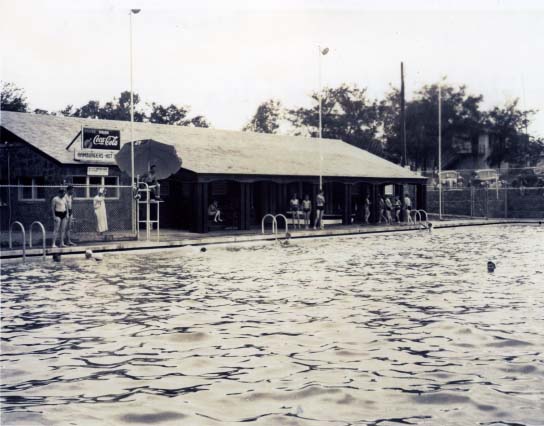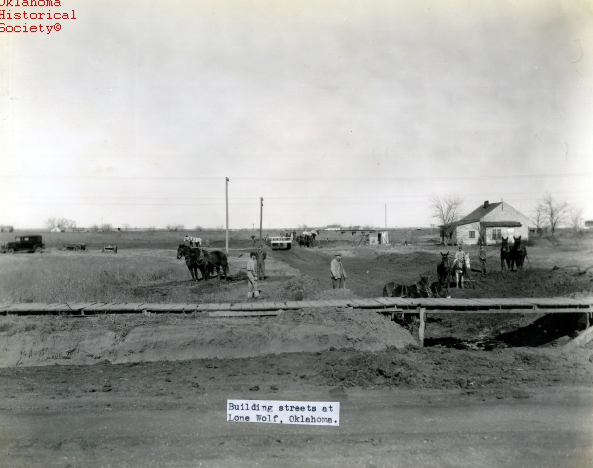The Encyclopedia of Oklahoma History and Culture
WORKS PROGRESS ADMINISTRATION.
During the Great Depression, anxious that the dole not become a "narcotic," in Pres. Franklin D. Roosevelt's words, the U.S. Congress in 1935 created the Works Progress Administration (WPA) to administer $5 billion for public works. The WPA's goal was to employ as many people as possible on projects that would provide long-term benefit to local communities. Ideally, workers would also receive on-the-job training to prepare them for further employment. The WPA made a significant impact on Oklahoma. Ultimately, of 166,000 Oklahomans certified for WPA jobs approximately 119,000 were employed at some point between 1935 and 1937. Including those recruited into a special drought-relief work program, more than half the state's work relief recipients were farmers. To encourage employers to provide private employment, project wages were lower than prevailing rates. Organized labor complained that the initial unskilled rate of eighteen cents an hour depressed all wages.
Harry L. Hopkins served as the national administrator. William S. Key, who had spent a career in public service, was the Oklahoma state administrator until 1937, when Ron Stephens replaced him. Initially, the WPA divided the state into eight regions, eventually expanding to nine. Oklahoma City served as headquarters. The Works Progress Administration was slow in establishing itself, creating a relief gap between the Federal Emergency Relief Administration (1933–35), as it wound down, and the Works Projects Administration (1939–43), as it got under way. By November 1935 ninety-two thousand were at work on federal projects. Local authorities inundated WPA administrators with plans. Local governments, as "sponsors," were supposed to share some of the expense. The federal government normally paid more than half the cost but sometimes footed as much as 95 percent of the bill. By 1937 the WPA had already spent more than $59 million in Oklahoma. Almost 70 percent compensated labor costs (relief), and 5.27 percent covered program administration. Other expenses included equipment and materials.
Construction was the WPA's mainstay. Road building and improvement, especially farm-to-market roads, accounted for almost half its expenditures in Oklahoma. Hundreds of school buildings, numerous National Guard armories, drainage projects, dams and reservoirs, and a number of municipal buildings are a part of the WPA legacy. Wherever possible, construction used local materials, explaining the prevalence of stone as a mainstay of WPA structures. For women the WPA set up sewing rooms and provided training in appropriately gendered professions such as librarianship, housekeeping, and cooking. WPA workers provided day care for their compatriots, and home demonstrations taught domestic skills. Special projects included mineral and geodetic surveys, an archaeological excavation at Spiro Mounds, preservation of Sequoyah's cabin, and extensive assistance to the Wichita Mountains Easter Pageant. The WPA helped workers obtain high school diplomas through a correspondence school and on-site academic instruction. The National Youth Administration, which served twenty thousand sixteen- to twenty-five-year-olds, was also a part of the Works Progress Administration.
Perhaps the most documented aspect of the Works Progress Administration was Federal One, an initiative to assist unemployed artists and white-collar professionals through four projects. Their general purpose was to make the arts accessible to all citizens, to uplift and inform, and to put artists to work. The projects met with varying degrees of success. The Oklahoma Federal Music Project, headed by Dean Richardson, was mainly effective. More than two hundred musicians participated in teaching, conducting music research, and playing in small-town orchestras and in an African American dance band. WPA musicians formed the nucleus of symphonies in Oklahoma City and Tulsa. Relations with both symphony boards were strained, but the Oklahoma City Symphony flourished. Teaching was probably the most successful activity, with as many as fifteen hundred classes conducted throughout the state at one point.
The visual art project, which employed about twenty-eight artists, supported both art and art instruction. Artists painted murals in public areas, exhibited in Oklahoma City and Tulsa, and produced an extensive number of silk-screen posters and other objects. The Oklahoma Federal Art Project developed the Oklahoma Art Center in Oklahoma City and created other centers around the state devoted to instruction and exhibits.
Partly because it was difficult to find professionals in the field, the Oklahoma Federal Theater Project averaged only twenty workers. Consequently, this project did as much teaching and research in drama as actual performance. Project workers spread throughout the state giving advice to community theaters, including several African American groups, helping the Oklahoma School for the Blind in Muskogee stage a play, instructing and entertaining residents of migrant camps in Oklahoma City, and training women in WPA sewing rooms in drama. The research arm of the Theater Project contributed a few plays and gathered reminiscences that could be molded into stage productions. The Vagabond Puppeteers was probably the most visible acting group. Director John Dunn, steering away from calls by national administrators for drama that would raise consciousness about economic injustices, promoted historical plays and comedies to entertain and amuse his mainly unemployed audiences. Later, commentators agreed that Dunn's sense of his audience was a foundation for the relative success of the Oklahoma Federal Theater Project.
William Cunningham, Oklahoma Federal Writers' Project director, commented on the difficulty of finding trained professionals, "We have considered it the main function of the project to put people to work and so of course have a great deal of dead wood." Although dead wood might have plagued Cunningham's project, he was the main focus of controversy. An English teacher at the University of Oklahoma, Cunningham had taught "Marxian economics" at the radical Commonwealth Labor College in Mena, Arkansas. Accused of hiring known Communists, he came under political pressure and resigned in 1938, as the House of Representatives Un-American Activities Committee (Dies Committee, or HUAC) brought Federal One under scrutiny.
Although nothing was published during his term, several projects Cunningham initiated came to fruition in later years. The WPA Guide to 1930s Oklahoma, assembled in part by historian Angie Debo, provided an overview of the state and offered helpful tour guides. Grant Foreman led a project that interviewed American Indians, pioneers, and former slaves, a major contribution to the state's oral history. The WPA also set up a records survey that rescued and processed a number of public documents and newspapers around the state. The surveyors worked with documents in the state capital, with the Five Tribes' records in Muskogee, and with county and municipal records, effectively saving a large part of Oklahoma's history.
By the time the Works Progress Administration (redesignated the Works Projects Administration in 1939) was "honorably discharged" by President Roosevelt in 1943, it had had a significant impact on Oklahoma. It had placed a large number of jobless Oklahomans to work, and it left behind a number of artifacts, as obvious as buildings and as subtle as public records catalogs.
Learn More
Accomplishments, Works Progress Administration for Oklahoma, W. S. Key, Administrator, July 1, 1935–March 1, 1937 (N.p.: N.p., 1937).
Norman W. Cooper, "Oklahoma in the Great Depression, 1930–1940: The Problem of Emergency Relief" (M.A. thesis, University of Oklahoma, 1973).
Kenneth E. Hendrickson, Jr., "Politics of Culture: The Federal Music Project in Oklahoma," The Chronicles of Oklahoma 63 (Winter 1985–86).
Suzanne H. Schrems, "White Collar Relief: Oklahoma Federal Theatre Project" (M.A. thesis, University of Oklahoma, 1987).
Stephen W. Simpson, "Red Dirt and Radio: An Oklahoma Perspective on the Federal Theatre Project" (M.A. thesis, University of Oklahoma, 2001).
Mary Ann Slater, "Politics and Art: The Controversial Birth of the Oklahoma Writers' Project," The Chronicles of Oklahoma 68 (Spring 1990).
Related Resources
Business, science, and aeronautics buildings under construction by WPA crews at the University of Oklahoma, 1936
(F2011.012.108, Haskell Pruett Collection, OHS)
Citation
The following (as per The Chicago Manual of Style, 17th edition) is the preferred citation for articles:
William H. Mullins, “Works Progress Administration,” The Encyclopedia of Oklahoma History and Culture, https://www.okhistory.org/publications/enc/entry?entry=WO022.
Published January 15, 2010
© Oklahoma Historical Society



